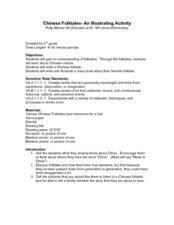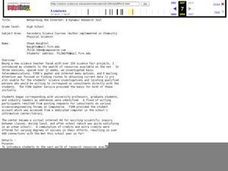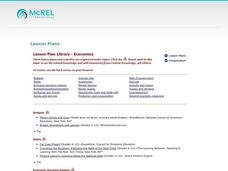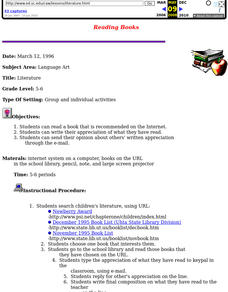Curated OER
George Washington Crossing the Delaware: A Study of Setting and Character
Students examine "Washington Crossing the Delaware." For this American Revolution lesson, students analyze the painting, research its background, and then perform skits based on their findings.
Hawaiʻi State Department of Education
Dance Critic
What do writing and dance have in common? They both have a six-trait rubric for assessment. Just like a good story, a good dance must have a hook, beginning, middle, end, logical sequence, and a climax. Learners use a structured...
Curated OER
Animal Self-portrait Mosaics: A Visual Arts Elective
Out-lined here is a two-week procedure that has the class creating ceramic animal tiles that are metaphorical representations of their own personalities. They discuss animal images found throughout history, what they mean, metaphor, and...
Curated OER
Comparing Cinderella and The Rough-Face Girl
Pupils examine similarities and differences between cultures. They'll see that literature, reading, and story telling is something all cultures have in common. They should construct Venn diagrams to help them compare and contrast the...
Education World
Edible Resource Maps!
Young scholars discuss resource maps and examine examples from library resources. Working in groups, they create edible resource maps by drawing examples, such as popcorn on the border of Iowa and Nebraska. Then they use cookies in the...
Curated OER
Antonyms, synonyms and homophones
Shed light on what antonyms, synonyms, and homophones are. For this lesson, upper elementary schoolers create pairs using an antonym, a homophone, and/or a synonym. Then they play an antonym matching game.
Curated OER
Plagiarism
Don't get caught plagiarizing! Before starting your research unit, use this lesson to help your young writers identify plagiarism. The truth is, many kids don't even realize when they're doing it! They practice citing sources when...
Curated OER
Chinese Folktales: An Illustrating Activity
In need of a really good lesson that incorporates literature, art, and cultural themes? After hearing a traditional Chinese folktale and discussing cultural themes and symbolism, learners create original illustrations for the story. This...
Curated OER
Coming Full Circle
Students develop and design their own clothing line in this Visual Arts activity about the intricacies of the fashion world. Emphasis is placed upon current and vintage designs, famous designers, and the development of individual design...
Curated OER
Networking the Internet: A Dynamic Research Tool
Learners engage in a lesson that is concerned with the research of finding information to help them develop new science projects. They conduct research using a variety of resources that includes e-mail and discussion groups.
Curated OER
The Daily Idiom
What is an idiom? Learners identify and read common idioms. They discuss what idioms are, and are given a black line master embedded in the plan that has 100 common idioms. Next, they complete "The Daily Idiom" worksheet, which is...
Curated OER
Reptiles and Amphibians
Introduce your class to various reptiles and amphibians. They will meet and identify a representative from each of the four major reptile families, then learn about and discuss reptile characteristics. Next, they will identify and...
Cornell University
Radical Reactions
The radical reactions of polymers seems abstract to many pupils, but this lesson turns them into a fun building game. Scholars use dice and building pieces to build polymers. Then, they determine the theoretical and experimental weight...
Curated OER
Dewey Decimal System
Students examine the Dewey Decimal System. In this Dewey Decimal System instructional activity, students participate in a Dewey Decimal System competition in order to learn how books are categorized in the library.
Curated OER
Because of Winn-Dixie
Pupils make connections with the book Because of Winn-Dixie through writing. In this writing instructional activity, students pretend to be the main character and write a letter to her mother, using very descriptive language. Pupils...
Curated OER
Writing Process
Fourth graders complete activities with the book Help! I'm a Prisoner in the Library by Eth Clifford. In this literature lesson, 4th graders read through chapter 4 of the book and respond to the policeman's phone calls. They choose from...
Curated OER
Message in a Bottle
Students read acts from The Tempest and complete analysis activities for the play. In this Shakespeare lesson, students read the first four acts of The Tempest and choose one of the characters to write a rescue message from their point...
Curated OER
Micro Economics - Personal Budgeting
Students explore the real world as it relates to money and how people use it. In this money management lesson, students jump into the real world as they role play with money through spending, saving, being married, single, having...
Curated OER
1st Grade - Act. 09: Freedom Quilt
First graders create sections of classroom quilt that be tied together.
Curated OER
Me on the Map Lesson 2
Students analyze and interpret maps, globes and geographic information systems to define and identify cities, counties, states, countries and continents to create a booklet called me on the map. They also determine and calculate the...
Curated OER
Government Lesson Plan: Lesson Plan 12
Learners investigate various political systems around the world. They complete a chart that compares the U.S. political system with other nations' governments, conduct research on a selected nation, and present an oral report.
Curated OER
Literature
Students read a book that is recommended on the Internet, then write their appreciation of what they have read. They send their opinion about others' written appreciation through the e-mail.
Curated OER
Lessons from a Holocaust Survivor
Young scholars investigate the life of a prisoner in the concentration camps of WWII during the Holocaust by performing research. The lesson helps students to "put a face" on prisoners of the concentration camps.
Curated OER
Using Information Resources: Lesson 2
Students are introduced to the various information resources. Individually, they practice skimming the table of contents, glossary and photographs in the excerpts. To end the instructional activity, they identify key words and answer...

























